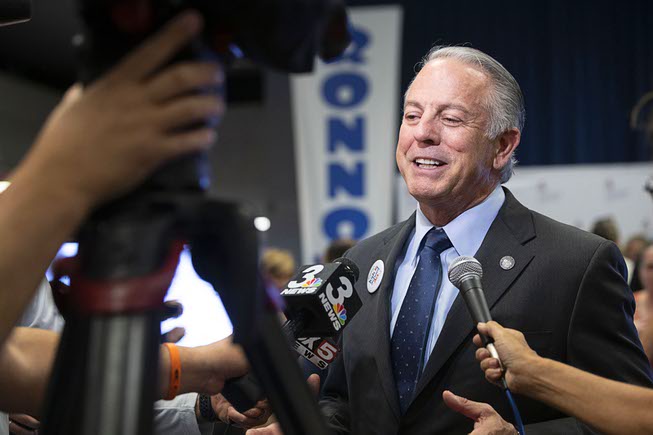
Nevada Governor Joe Lombardo takes questions from reporters after a ceremonial signing of Senate Bill 189, the Keeping Kids in School Act, at Ronnow Elementary School Thursday, July 6, 2023. The bill includes a $2 million appropriation for Communities In Schools of Nevada.
Friday, July 14, 2023 | 2 a.m.
Climate change in Nevada
Gov. Joe Lombardo’s decision this month to withdraw Nevada from the U.S. Climate Alliance is being blasted by progressives and climate activists who warn such a move will be counterproductive to diversifying the state’s economy and energy sector at a time when climate and weather disasters have increased globally.
The Republican governor sent a letter dated July 5 to Casey Katims, executive director of the U.S. Climate Alliance, stating the collective’s mission is “ambitious and well intentioned” but conflicts with Nevada’s greater energy objectives. The U.S. Climate Alliance was incorporated in 2017 after then-President Donald Trump withdrew the United States from the 2015 Paris Climate Agreement.
In March, Lombardo signed an executive order establishing the state’s energy goals, which include reincorporating natural gas for home use and generating electricity, while also encouraging expanded use of harvesting power through solar, wind, geothermal and other renewable sources.
“These objectives are focused on developing and maintaining a diverse energy supply portfolio and utilizing a balanced approach to electric and natural gas energy supply and transportation fuels that emphasizes affordability and reliability for consumers,” Lombardo wrote to Katims. “While the goals of the U.S. Climate Alliance are ambitious and well-intentioned, these goals conflict with Nevada’s energy policy objectives. Therefore, I have decided to withdraw the State of Nevada’s membership from the U.S. Climate Alliance.”
With Nevada’s withdrawal, the alliance now consists of 23 states, as well as the territories of Puerto Rico and Guam. Arizona joined the alliance this week, according to its website. Member states work toward achieving the Paris Agreement’s goal of keeping Earth’s temperature below 1.5 degrees Celsius from the pre-industrial era. They also seek to reduce greenhouse emissions by at least 50% by 2030 and net-zero emissions by 2050, which most leading experts say is necessary to avoid the most devastating effects of climate change.
While disappointed by Lombardo’s decision to pull Nevada out of the accord, U.S. Climate Alliance spokesman Evan Westrup said the Silver State would always be allowed to rejoin the group.
“As unprecedented wildfire smoke, record heat and catastrophic floods sweep across the country, we need every state and every governor — no matter their politics — confronting this crisis,” Westrup wrote in a statement. “We’re disappointed Gov. Lombardo has decided to move in another direction, and should he reconsider, our door is open.”
Others were more critical.
“We are outraged by Gov. Lombardo’s nonsensical withdrawal of Nevada from the U.S. Climate Alliance,” Nevada Conservation League executive director Paul Selberg said in a statement. “He took this action without consulting everyday Nevadans, advocacy groups or leaders within the environmental community, and it contradicts his own administration’s goals of economic diversification through clean energy.”
Selberg continued: “While Nevada is being hit hard with record temperatures and soaring energy bills, Lombardo is putting utilities and their profits first. This is a step backward that undermines the voices of Nevadans who consistently support clean energy and climate action.”
Lombardo’s decision also seems to run counter to the plans of the state’s largest electric utility, NV Energy, which aims to phase out its plants that generate electricity using natural gas and is aiming for a net-zero carbon output by 2050, according to Tony Sanchez, NV Energy’s executive vice president of business development and external relations.
The utility has already reduced carbon emissions in its power generation by 55% compared with 2005 levels, and is emphasizing more in-state solar and geothermal generation to keep energy prices flat, Sanchez said.
Climate experts say increasing temperatures contribute to sea level rise and exacerbate weather extremes like flooding, storms and wildfires.
Given that Nevada is situated in the heart of the Mojave Desert in the midst of a decades-long drought plaguing most of the West, one critic ofthe withdrawal said she thought officials here would be more sensitive to climate action.
“As the driest state in the nation with two of the fastest-warming cities, Nevada’s elected officials should be doubling down on addressing the climate crisis,” Laura Martin, executive director of the Progressive Leadership Alliance of Nevada, said in a release. “Lombardo’s decision to withdraw from the U.S. Climate Alliance is taking our state backward when we should be the leaders in sustainability. After failing to pass any substantial protections against the climate crisis during (the recently concluded legislative) session, this decision is yet another signal from Lombardo that he is willing to turn his back on Nevadans, in favor of corporations and fossil fuels.”
Lombardo on May 31 vetoed a proposal with bipartisan support, Senate Bill 169, which sought to require Clark and Washoe counties to develop contingencies for heat mitigation as part of their master plans. The Legislature this session failed to move a separate measure that would have created guidelines for employers whose employees work in extreme heat.
But Lombardo signed into law Assembly Bill 184, which creates a voucher program for state contractors to transition to zero-emission medium- and heavy-duty work vehicles and signed into law another bill, Assembly Bill 220, to curb excessive water use in part by giving the Southern Nevada Water Authority the ability to restrict residential access whenever a deep water shortage is declared for the Colorado River.
As of Wednesday, approximately 111 million people in the U.S. were under an excessive heat advisory, the National Weather Service reported, with the bulk of those warnings in effect in states across the Southwest. The weather service has placed Las Vegas under an excessive heat warning until 8 p.m. Tuesday, with temperatures expected to reach as high as 117 degrees.
